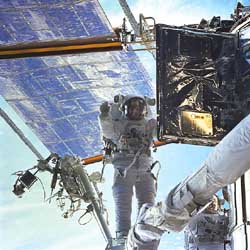Alumnus will travel with Lab Schools’ project to Hubble Space Telescope
By Steve KoppesNews Office
 John Grunsfeld (S.M., ’84; Ph.D., ’88) (above) last serviced the Hubble Space Telescope during a 1999 mission. |
Last year, when third-grade teacher Blue Balliett’s Laboratory Schools class began drawing three-dimensional objects, which they called “Cubes in Space,” little did they know that some of them would become “cubes in outer space.” NASA astronaut and University alumnus John Grunsfeld (S.M., ’84, Ph.D., ’88) will carry the pupils’ project Cubes in Space into orbit aboard space shuttle Columbia on Thursday, Feb. 28.
The main purpose of Grunsfeld’s mission is to install new instruments that will greatly improve the scientific usefulness of the Hubble Space Telescope, which is named for fellow University alumnus Edwin Hubble (S.B., ’10, Ph.D., ’17). Grunsfeld also will take the front page of Hubble’s doctoral dissertation into orbit in addition to the project completed by the third-graders at the Laboratory Schools.
 The artwork above was created by Ricardo Scheiber-Camoretti, a third-grade pupil in Blue Balliett’s class at the Laboratory Schools. It is one of the images on the CD that astronaut John Grunsfeld will carry into orbit during his Hubble Space Telescope mission at the end of this month. |
“The kids love the idea of having this piece of work that came out of the classroom actually leave the surface of the Earth,” Balliett said. “They immediately picked up on the idea that it’s a fabulous experience that many people never have.”
The idea grew out of an encounter last October between Grunsfeld and Michael Turner, the Bruce V. and Diana M. Rauner Distinguished Service Professor in Astronomy & Astrophysics, during a conference on campus. Turner’s son, Joe, is a student in Balliett’s class.
 |
The writings and drawings that all 24 of Balliett’s pupils produced, as well as the pupils’ photographs have been saved onto a CD that Grunsfeld will take aboard the shuttle later this month.
“I work out curriculum with the kids and try to involve them in the decision-making process as much as possible,” Balliett said. “So I told them about Mike Turner calling and said, ‘would you like to work on putting together a CD?’ We only had three weeks to do it, so it was pretty labor-intensive for them. They said, ‘yes, yes, yes.’”
The children wrote stories and poems on subjects ranging from time travel and gypsy dancing to baseball games and stinky sunflowers from Saturn. One student, Amir Hay, wrote a letter to an alien, just in case Grunsfeld encountered one.
 Laboratory Schools third-graders (left to right) Charlotte Lastra, Ricardo Scheiber-Camoretti and Charles Du created drawings for the CD project, Cubes in Space, which will be taken to the Hubble Space Telescope by astronaut and alumnus John Grunsfeld. Above their photo is Charles’ artwork, and Charlotte’s piece is below, at left. |
“Dear Mr. Alien,” Hay wrote, “If you’re Evil, sorry I gave you this note. I was hoping aliens have a lot of technology. And astronaut Grunsfeld is going to go up into space and going to deliver this note to you. I was hoping you guys know how to build robots, because if you do you could build them for the whole world.
“We want robots that cure diseases for people and animals. We want robots that make Food. We want robots that make peace. We want robots that help the homeless. Thank you.”
Most of the drawings also followed a space theme. Images of rockets, the Earth and moon, the Hubble Space Telescope and pentominos––the Cubes in Space––all earned a place on the CD.
Grunsfeld last flew into orbit in 1999, when he performed two space walks totaling more than 16 hours on that servicing mission. He is scheduled to perform three space walks during the coming mission. Since 1995, Grunsfeld has logged more than 34 days in space on three shuttle flights.
 |
Published in 1920 by the University Press as a publication of the Yerkes Observatory, Hubble’s dissertation is titled “Photographic Investigations of Faint Nebulae.” In Hubble’s day, nebulae were faint patches in the sky of unknown identity. Although not famous for his dissertation, Hubble did eventually establish nebulae as separate galaxies, which existed only in theory at the time.
After Grunsfeld and his fellow astronauts have finished upgrading Hubble’s orbiting namesake, the telescope’s new Advanced Camera for Surveys will provide 10 times more “discovery power” than the camera it replaces. With the newly equipped Hubble Telescope, astronomers will better be able study everything from planets orbiting nearby stars to distant galaxies as they looked six billion years ago, when the universe was approximately half its current age.
![[Chronicle]](/images/small-header.gif)